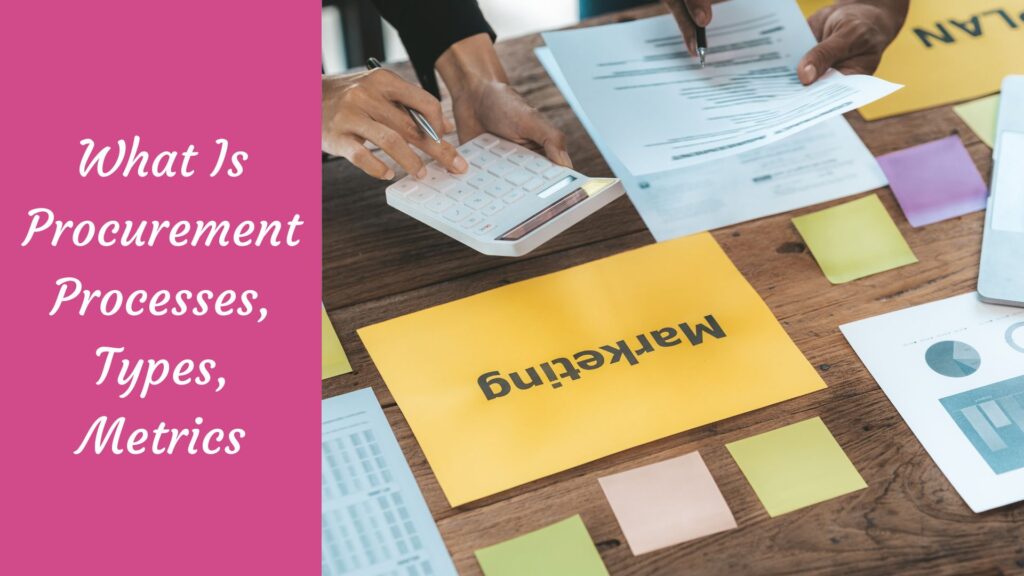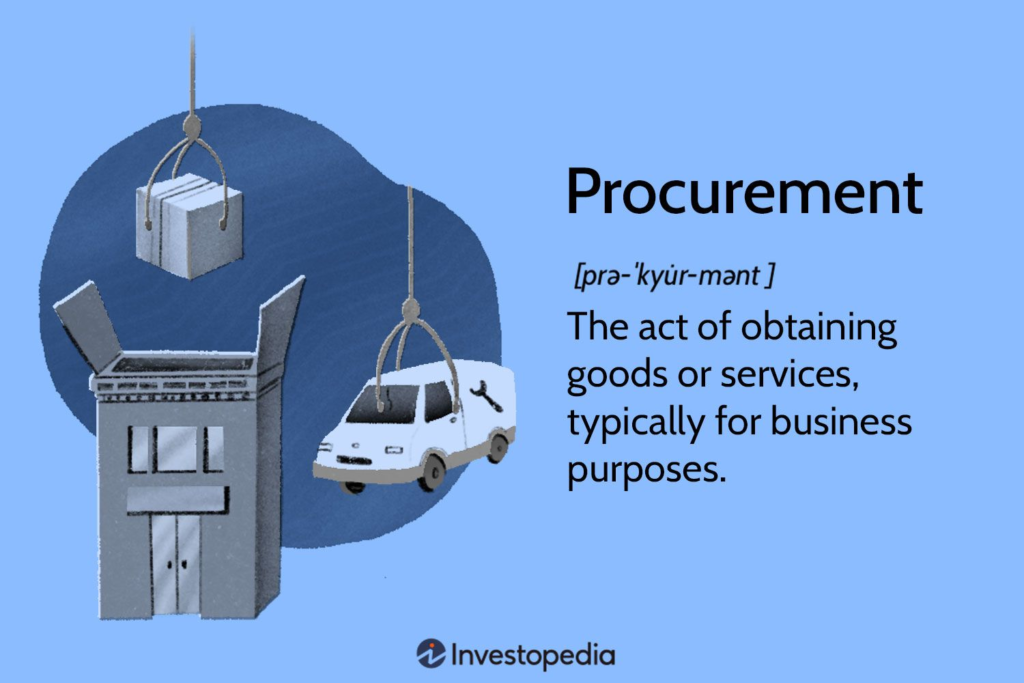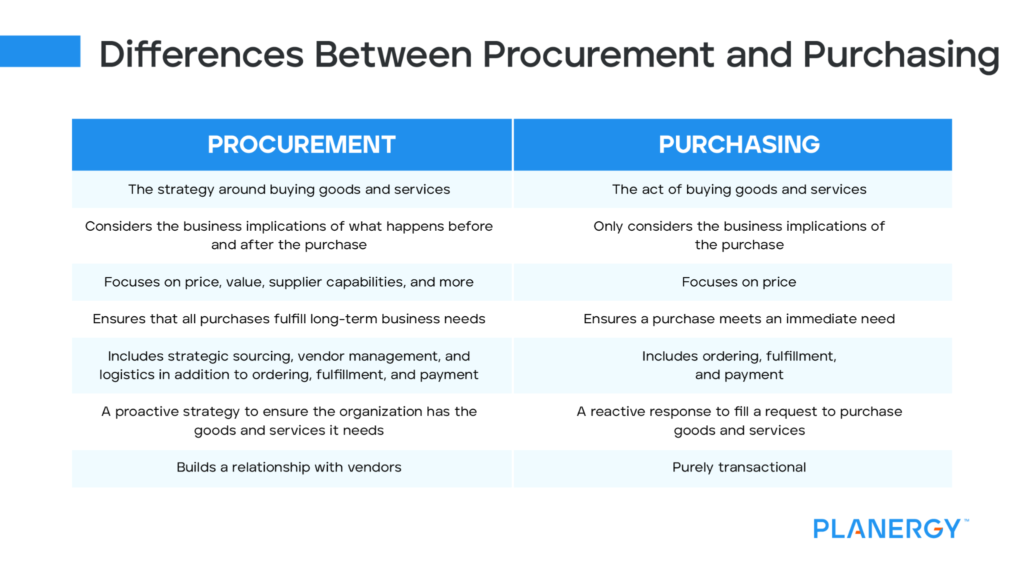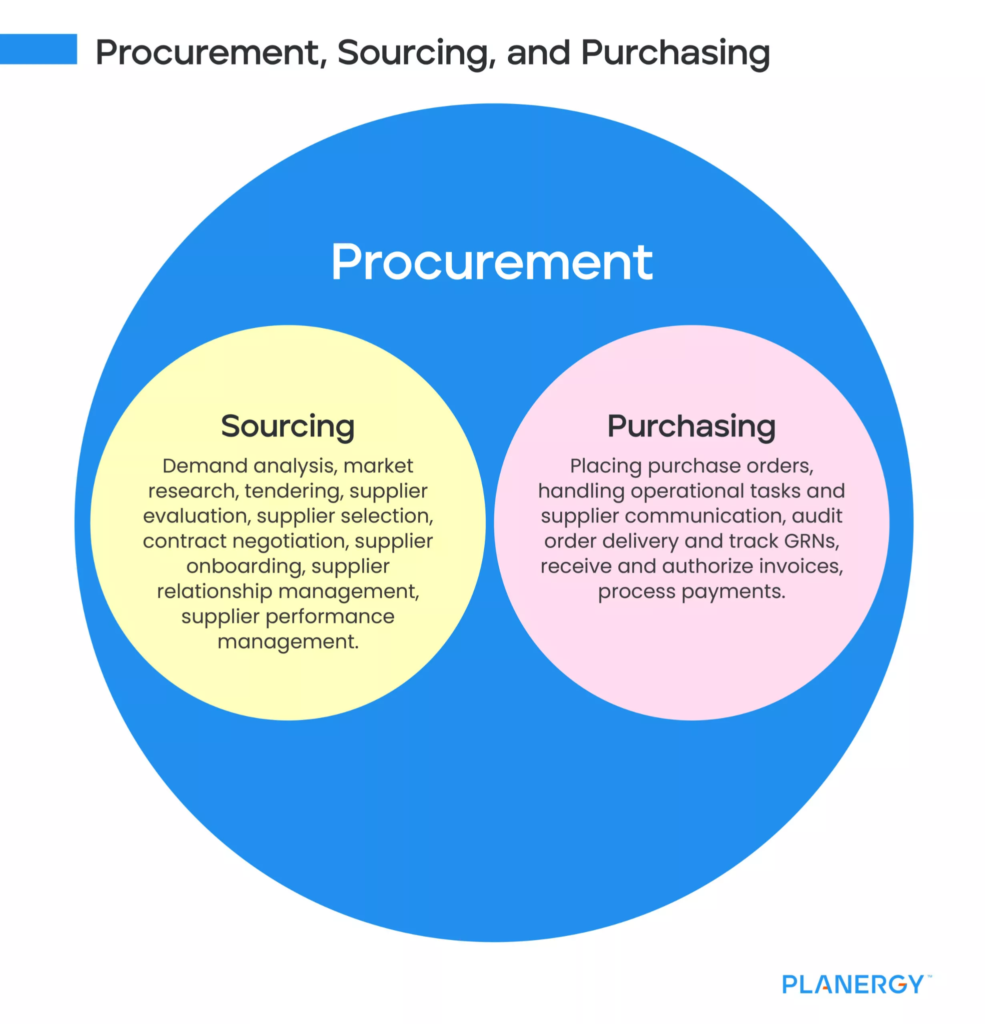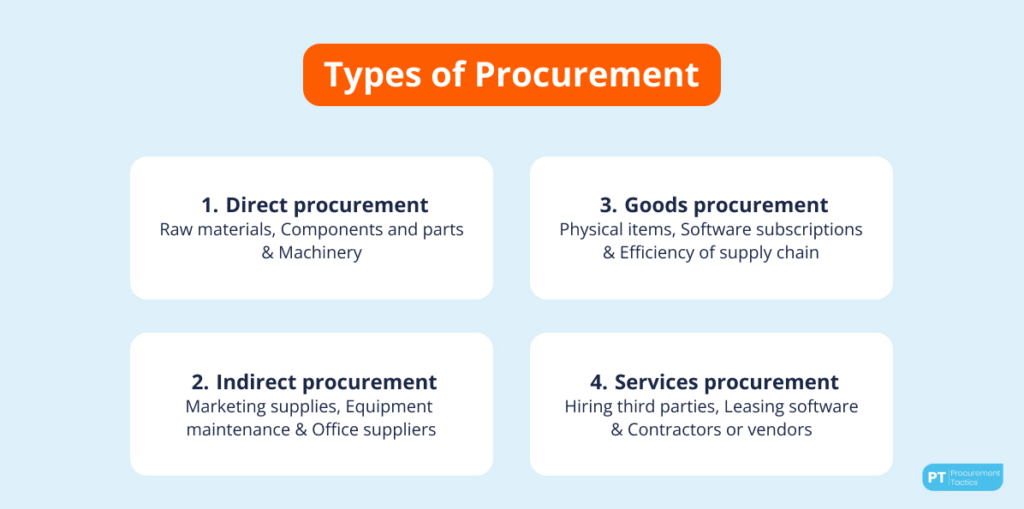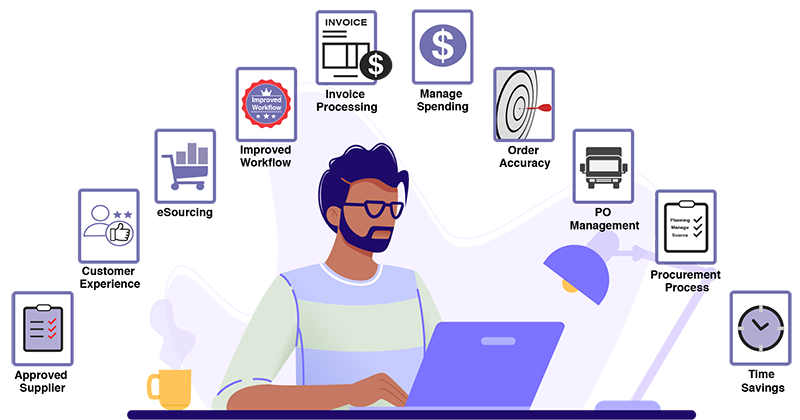In today’s fast-paced business world, the efficiency of procurement processes can be the linchpin for a company’s financial health and operational success. Yet, many organizations find themselves grappling with outdated procurement. strategies that are time-consuming and costly, leading to missed opportunities and reduced competitive edge.
In this digital era, the need for agility, transparency, and streamlining in procurement is more critical than ever.
Thankfully, our comprehensive blog is your ultimate guide in navigating the complex procurement landscape. From exploring the intricacies of various procurement processes and types to employing strategic metrics that drive success, we equip you with the knowledge and tools necessary to transform your procurement strategy.
Stay ahead of the curve and unlock the full potential of your operations—our blog is here to show you how.
What is Procurement?
Procurement is basically like the shopping department of a company, but it’s way more strategic and crucial than just picking up some office supplies. It involves:
- Finding what the company needs to keep everything running smoothly. Think of everything from the paper in the printers to the software that keeps your accounts in check.
- Negotiating deals with suppliers. Just like you might haggle over a car’s price, procurement involves negotiating to get the best possible deal for the company.
- Making sure what’s ordered arrives and works. It’s no good if you order a bunch of new computers, but they end up being the wrong model or arriving too late.
Here are some examples to break it down:
- Direct Procurement: A company buys the raw materials it needs to make its products. Direct procurement is about getting the wax, wicks, and scents if you’re a company making candles.
- Indirect Procurement: This covers everything that doesn’t go directly into a product but is still essential. Think of things like cleaning services for the office, IT support, or even the coffee in the break room.
- Services Procurement: Sometimes, it’s not about the goods but about hiring someone to do a job. For example, if a company needs a new advertising campaign, they’ll procure (or hire) an ad agency to help them.
- E-procurement: Welcome to the digital age! E-procurement means using online systems to make the whole procuring process simpler and faster. Instead of flipping through catalogs or faxing orders, everything can be done with a few clicks.
Procurement is like the behind-the-scenes hero in businesses, ensuring everything needed is there, at the right time, at the right price, and of the right quality so that the rest of the company can do business as usual.
Procurement vs Purchasing
Procurement and purchasing are two terms that often get tossed around like they’re the same thing, but they actually play distinct roles within a company. Think of it this way:
Procurement is a big-picture process. It’s like planning for a huge Thanksgiving dinner. You’re figuring out what dishes to serve, sourcing the best ingredients, and ensuring you get them for a good price and on time. It’s a strategic process that includes:
- Researching what’s needed
- Selecting the best suppliers
- Negotiating contracts and terms
- Planning for long-term needs
Purchasing, on the other hand, is like going to the store with your shopping list, picking up the turkey, cranberries, and all the other fixings, and then paying for them. It’s the transactional part of procurement, focusing on the actual buying part. This includes:
- Placing orders
- Receiving goods and services
- Making payments
To give you a real-world example, imagine a restaurant. Procurement is when the manager decides on the menu for the next season, chooses which suppliers to get ingredients from, and negotiates prices for bulk orders of those ingredients, aiming to get the best quality for the best price. They’re planning for this week’s menu and the long haul.
Purchasing happens when the chef needs more tomatoes for tonight’s service, so they order a batch from the selected supplier. It’s a specific, singular act of buying what the restaurant needs.
In essence, procurement is the strategy behind buying, making smart decisions about what, who, and how to buy, while purchasing is buying itself. Both are crucial but tackle different parts of getting what a company needs.
Procurement vs Strategic Sourcing
When discussing running a business, you hear much about procurement and strategic sourcing. They might sound like fancy business jargon, but they’re pretty straightforward concepts—and super important.
Procurement is like your shopping list for the business. It’s all about getting the stuff your company needs to keep humming along, whether it’s paper for the printer, new laptops, or even coffee for the break room. It’s the nitty-gritty of figuring out what you need, buying it, and ensuring it arrives on time and does what it’s supposed to do.
Strategic Sourcing, on the other hand, takes things up a notch. It’s like planning how you will shop for the next year to save money, improve quality, and maybe even score some perks. Strategic sourcing is about:
Look at the big picture and determine how to get the best value for your spending.
- Building strong relationships with suppliers so you can work out the best deals.
- Thinking long-term about what your company’s gonna need down the road and how you can get that most smartly.
Here are a couple of examples to break it down:
Say your company decides it’s time to upgrade all your office computers. Procurement would handle the specifics—figuring out what models to buy, placing the orders, and ensuring they’re delivered and set up correctly.
However, strategic sourcing would have started way earlier. It would involve analyzing the company’s future tech needs, researching the best suppliers, and negotiating contracts that might include good prices and things like on-site support and warranties. It’s all about getting the biggest bang for your buck with an eye on future needs and potential savings.
While procurement focuses on the buying process, strategic sourcing plays the long game, focusing on creating value through smart planning and negotiation. They aim to ensure your company has what it needs to succeed but tackle the challenge from different angles.
Types of Procurement
When we break down all the ways a business can get what it needs, there’s a whole lineup of procurement types to consider. Each type has its own focus, from the materials that turn into products to the services that keep everything running smoothly. Here’s a rundown:
Raw Materials Procurement: Think of a bakery needing flour, sugar, and eggs. It’s all about sourcing the essential ingredients to whip up those delicious goods. Without these supplies, there’s no product to sell.
- Example: A chocolate factory purchasing cocoa beans directly from farmers.
Manufacturing Procurement: This one’s for the factories and the makers. It involves buying anything that contributes to creating a product but isn’t the raw material itself. This could include machinery, parts, and even the tools used on the manufacturing floor.
- Example: An automobile manufacturer purchasing engine parts and assembly line equipment.
Service Procurement: Sometimes, what a business needs isn’t a thing but a service. This could be anything from hiring a marketing firm to spruce your brand to contracting a cleaning service to keep the office spotless.
- Example: A tech startup hiring a software development agency to create its mobile app.
Capital Goods Procurement: Big-ticket items fall into this category. We’re talking about a company’s purchases to invest in its future, like buying new technology systems or constructing a new office building.
- Example: A corporation purchasing a fleet of vehicles for employee use.
MRO (Maintenance, Repair, and Operations) Procurement: This is all about keeping the lights on and the engines running. MRO procurement ensures businesses have all the bits and bobs needed to maintain, repair, and carry out daily operations smoothly.
- Example: An airline company buying airplane spare parts and maintenance services.
Each type of procurement plays a unique role in keeping businesses up and running. By understanding these different types, companies can make smarter decisions about spending their money, ensuring they have exactly what they need to keep chugging along efficiently.
How Does Procurement Impact Business
Procurement isn’t just a fancy term for buying stuff—it’s a crucial gear in the engine of any business, big or small. Think about it like this: without smart procurement strategies, companies might spend way more money than they need to, or worse, run out of essential supplies at critical moments. Here’s how procurement makes a real difference:
Cost Savings: Businesses can save a chunk of change by negotiating better deals and finding the most cost-effective suppliers. Money saved here can be rerouted to other important areas, like R&D or marketing.
- Example: A restaurant negotiating contracts with local farmers to supply seasonal produce at a lower cost.
Quality Control: With a solid procurement process, companies can ensure they get top-notch materials or services, which means the end product is better. Happy customers often lead to repeat business.
- Example: A clothing brand sourcing high-quality, sustainable fabric to produce garments that last longer and appeal to eco-conscious consumers.
Risk Management: Smart procurement involves vetting suppliers for reliability, which reduces the risk of delays or disruptions in the supply chain. It’s like having a backup plan for your backup plan.
- Example: An electronics manufacturer using multiple suppliers for critical components to avoid production halts in case of a shortage.
Innovation: By building strong relationships with suppliers, businesses can gain access to the latest products and technologies, helping them stay ahead of the curve and offer something new and exciting to their customers.
- Example: A tech company partnering with a software developer to create a custom solution that improves customer service.
Sustainability: Good procurement practices can also align with a company’s sustainability goals by choosing eco-friendly materials and suppliers that adhere to ethical practices.
- Example: A coffee shop chain sourcing beans from fair-trade certified farmers to ensure ethical treatment of workers and sustainable farming practices.
In essence, procurement is like the unsung hero of the business world. It works behind the scenes to ensure that a company runs smoothly, stays innovative, and keeps its customers satisfied—all while watching the bottom line. It’s not just about spending money; it’s about spending it wisely.
8 Steps in the Procurement Process Flow
Navigating the procurement process can seem like a complex dance, but it’s really just about getting from point A to point B as smoothly as possible. Here’s a step-by-step guide that breaks it down into manageable pieces:
Identify the Need: It starts with spotting something missing, like realizing your office is low on printer paper before report season hits.
- Example: A restaurant notices that they’re running low on steak before a big weekend.
Supplier Selection: Think of this as shopping around. You’re checking out different stores (or suppliers) to see who has the best steak at the best price.
- Example: A construction company comparing prices for steel from different suppliers.
Price Negotiation: Now you’re haggling at the flea market, trying to get that vintage lamp at the lowest price possible. Except it’s more professional and usually involves contracts.
- Example: A school district negotiating a bulk purchase of textbooks at a discount.
Purchase Order: This is when you officially say, “I’ll take it!” by sending a purchase order to the supplier.
- Example: An IT company ordering a new batch of laptops for their staff.
Delivery: The waiting game. It’s just like tracking your online order, except sometimes a truckload of materials shows up at your warehouse.
- Example: A fashion retailer receiving a shipment of new season clothing.
Inspection and Acceptance: You’re checking your delivery to make sure everything’s there and nothing’s broken—like making sure all pieces of your new grill are in the box.
- Example: A manufacturing firm inspecting a delivery of parts for quality before accepting them.
Invoice Approval and Payment: Once you’re happy, it’s time to pay up. This step involves reviewing and approving the invoice before making the payment.
- Example: A hotel settling an invoice to deliver new bedding for its rooms.
Record Keeping: You’re filing away receipts and order forms, so you have a record of everything. This is crucial for budgeting, audits, and planning future purchases.
- Example: A government agency keeps meticulous records of all procurement activities for compliance and auditing.
Performance Review: Last but not least, you’re looking back to see how it all went. Was the supplier on time? Was the product up to snuff? This helps in making future procurement decisions.
- Example: A coffee shop reviewing the quality and delivery timeliness of coffee beans from different suppliers to decide on future orders.
Each step in the procurement process is like a puzzle piece, fitting together to help businesses operate smoothly, save money, and stay stocked up on all the essentials. It’s not just about buying stuff; it’s about buying smart.
Mini Case Study: The World Bank
The World Bank is a prime example of procurement’s impact on global projects. Engaging with countless initiatives worldwide, this institution exemplifies how effective procurement strategies can foster development and growth, especially in emerging markets. Here’s how the World Bank nails it:
Global Impact through Strategic Procurement: The World Bank’s projects often target infrastructure, healthcare, and education improvements in developing countries. By carefully selecting suppliers and ensuring competitive bidding, they ensure that funds are used efficiently, leading to more impactful outcomes.
- Example: In a project to improve rural education in Africa, the World Bank ensured the procurement of high-quality educational materials by setting strict quality standards and engaging in transparent bidding processes.
Fostering Local Economies: One of the key strategies involves prioritizing local suppliers for projects. This supports the local economy and reduces logistical challenges and costs.
- Example: For a healthcare project in Southeast Asia, the World Bank preferred local pharmaceutical suppliers that met its quality standards, thereby boosting the local pharmaceutical industry.
Innovation and Sustainability: The World Bank often integrates innovative and sustainable solutions into its procurement requirements, encouraging suppliers to offer greener and more efficient products and services.
- Example: In a bid to promote sustainable energy solutions in South America, the institution required solar panel suppliers for a project to have a minimum of a 20% recycling policy for their products.
Efficiency and Transparency: The institution has adopted digital tools for procurement processes, leading to enhanced efficiency and transparency, which are crucial for accountability in handling public funds.
- Example: Leveraging an online procurement system allowed for the real-time tracking of bids and contracts for a water purification project in Eastern Europe, ensuring fairness and transparency in supplier selection.
Capacity Building: Beyond just procurement, the World Bank also focuses on building procurement capacity in the countries it serves. This involves training local officials and suppliers in best practices, ensuring sustainable development.
- Example: Conducting workshops and seminars for local government officials in Central Asia on the importance of transparency and efficiency in procurement, thereby improving the region’s overall procurement practices.
The World Bank’s procurement framework showcases a blend of efficiency, sustainability, and strategic supplier engagement. Through its procurement activities, the World Bank ensures that projects are completed successfully and contributes to the broader goal of sustainable development and capacity building in emerging markets.
KPIs & Metrics for Monitoring the Procurement Process
Monitoring the procurement process effectively is crucial for any business aiming to optimize its operations and cut unnecessary costs. Understanding which Key Performance Indicators (KPIs) and metrics to monitor can make a difference. Here’s a simplified breakdown to keep things straight:
Cost Savings: The bread and butter of procurement. This KPI measures how much you save in the procurement process compared to previous periods.
- Example: Last year, it cost you $10,000 to order office supplies, but this year, after negotiating better deals, it’s down to $7,500. That’s a $2,500 saving!
Time to Procure: How long does it take from identifying a need until the product or service is delivered?
- Example: If it took six weeks to get those new office chairs last time and now it’s down to four, your procurement process is getting leaner and meaner.
Supplier Compliance Rate: This measures how often suppliers meet your company’s standards or contractual agreements.
- Example: Out of 100 orders, if 97 arrive on time, in perfect condition, and meet all your criteria, you’ve got a 97% compliance rate.
Purchase Order Cycle Time: The average time to complete a purchase order.
- Example: If drafting, approving, and fulfilling a purchase order usually takes ten days, but you’ve managed to cut it to seven, you’re on the right track.
Quality Defects Rate: Keeping tabs on the percentage of goods or services that don’t meet quality standards upon delivery.
- Example: If last year 5 out of every 100 widgets were duds and this year it’s only 2, your suppliers are doing a better job (or your quality control is).
Vendor Lead Time: The time from placing an order with a supplier to receiving it.
- Example: If the lead time for computer parts was 30 days and now 25, your suppliers are becoming more responsive.
By focusing on these KPIs, businesses can clearly understand what’s working and what’s not in their procurement process. It’s all about buying smarter, saving money, and ensuring you get what you need when you need it, without a hitch. Keep tracking these metrics; you’ll keep your procurement process sleek, cost-effective, and on point.
5 Best Practices to Optimize the Procurement Process
Optimizing the procurement process is like ensuring your car runs smoothly without hiccups. It’s about efficiency, saving money, and keeping things rolling without unnecessary drama. Here are five golden rules to tune up your procurement engine:
Leverage Technology: It’s the digital age, folks. Using procurement software isn’t just cool; it’s a game changer. It helps you automate the nitty-gritty, like processing orders and tracking shipments, so you can focus on the bigger picture.
- Example: Think of swapping out a paper-based order system with a slick online platform. You can see everything happening in real time, reducing errors and saving time.
Build Strong Relationships with Suppliers: This is key. Treat your suppliers like partners, not just vendors. Good relationships mean you can work out better deals and maybe get a heads-up on any issues before they become problems.
- Example: Set up regular check-ins with your suppliers. A simple monthly coffee catch-up can do wonders for smoothing any bumps down the road.
Implement a Strategic Sourcing Process: Don’t just buy on a whim. Have a plan. Identify what you need, research potential suppliers, and evaluate your options carefully. It’s about buying smart.
- Example: If you need new office computers, don’t just buy from the first supplier you find. Compare prices, warranties, and service options. Maybe even consider leasing for a better fit for your needs.
Train Your Team: Everyone involved in procurement needs to be on their A-game. Regular training on the latest best practices and tools keeps your team sharp and your process efficient.
- Example: Host a workshop on negotiation techniques or using that new procurement software. It’s all about empowering your team with the knowledge they need.
Regularly Review and Optimize Your Process: The job is never done. Always look for ways to improve. What worked last year might not be the best approach now. Stay agile and be ready to adapt.
- Example: Once a quarter, sit down and review your procurement metrics. Are you seeing the cost savings you expected? Is the process running smoothly? If something’s off, dig into why and fix it.
5 Best Procurement Software Tools in 2024
Choosing the right procurement software is like finding the perfect assistant; it’s all about making your life easier and your business smoother. Here’s the skinny on the top 5 procurement software tools in 2024, each with its unique flair:
ProcurePro+: This is the Swiss army knife of procurement tools. It’s got everything from automated purchase orders to predictive analytics that can forecast your needs before you even know them.
- Example: Imagine it’s predicting you’ll run low on printer ink next month and automatically queue up an order. Saves you the hassle, right?
SupplierSync: Now, this is where things get interesting for those who value relationships with vendors. SupplierSync makes communication a breeze, allowing seamless collaboration and direct negotiation through the platform.
- Example: You got an order that’s running late? A quick message through SupplierSync can get you an update straight from your supplier’s desk.
CloudContracts: Focused on the digital paper trail, it stores and manages all your contracts in the cloud. Access, review, and renew contracts without digging through file cabinets or cluttered email inboxes.
- Example: You’re wondering when your office lease agreement will be renewed. With a few clicks in CloudContracts, you have your answer and can start the renegotiation process right there.
InventoryIntel: This tool offers real-time inventory tracking that integrates smoothly with your order system. It’s all about having the right amount of stock without overdoing it.
- Example: Say goodbye to the days of realizing too late that you’re out of a crucial component for your manufacturing process. InventoryIntel has your back.
EcoProcure: Sustainability is the name of the game here. It helps companies make greener choices by highlighting eco-friendly suppliers and products.
- Example: Looking to reduce your carbon footprint? EcoProcure can filter options to show you suppliers that use renewable energy and sustainable practices, making it a no-brainer to choose better for the planet.
Each of these tools brings something unique to the table, geared towards making procurement a seamless, efficient, and even enjoyable part of your business operations.
CONCLUSION
Navigating the procurement process efficiently is paramount for businesses aiming to thrive. The paradigm shift towards digitalization, strategic sourcing, and sustainable practices streamlines operations and fosters stronger supplier relationships, ensuring a resilient supply chain.
Leveraging the right technology, like ProcurePro+ or EcoProcure, empowers businesses with tools for real-time monitoring, automated purchasing, and eco-friendly choices, enhancing overall procurement strategies.
Remember, success in procurement doesn’t solely rely on implementing technology but also on nurturing relationships, continual learning, and process optimization. In a rapidly evolving market, staying informed and adaptable is key.
For those looking to deepen their understanding and elevate their procurement process, exploring advanced tools and strategies will pave the way for more informed decisions and sustainable growth.
LEARN MORE about optimizing
Looking to elevate your procurement game to the next level? ONBOARDSAAS is your go-to platform for streamlining, optimizing, and revolutionizing your procurement processes. Don’t miss out on the chance to leverage the power of technology to save time, reduce costs, and enhance efficiency in a way you’ve never experienced before.
Start your journey towards a smarter procurement strategy today. Get Started with ONBOARDSAAS.com Now! your procurement process and the latest in procurement technology to stay ahead of the curve.

10+ years experience in Marketing and Operations
